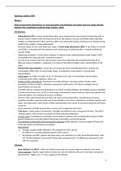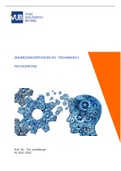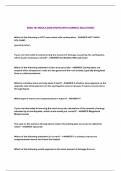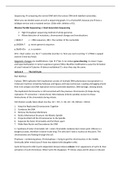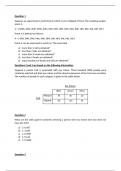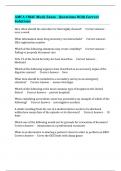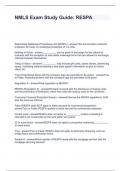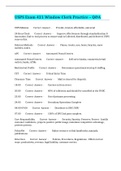Week 1.
Body representation disturbances in visual perception and affordance perception persist in eating disorder
patients after completing treatment (Engel & Keizer, 2018).
Introduction.
- Eating disorder (ED) = severe mental illness that causes impairments in psychosocial functioning and/ or
physical health. Patients with AN (anorexia nervosa), BN (bulimia nervosa) and OFSED (Other Specified
Feeding or Eating Disorder) often report to suffer from unbearable feeling of being too fat, despite having
healthy body weight or being underweight.
Incorrect notion of one’s own body size/ shape body image disturbance (BID) key feature in AN, BN
and OFSED + associated with development and maintenance of eating disorder + relapse predicted by
severity of BID.
- Optimizing treatment + ensure fewer relapses acquire clearer understanding of body image in CEDT
(Completed their Eating Disorder Treatment) patients.
- Current study assumes that the brain processes primarily multimodal info pertaining the body from
different sensory modalities + integrates it to coherent and abstract higher order representation of the
body.
Mental body representation = stores info concerning the body, including dimensions of body size.
Terminology of BID refers to mental body image emphasizes visual aspects of mental body
representation.
In this paper: term BID in broader sense referring to full scope of mental body representation,
containing visual tactile, cognitions, affect, etc.
- Studies on BID in ED patients: disturbances in bodily attitudes, visual perception of body, haptic
perception, tactile perception, affordance perception/ bodily action linked to enlarged mental
representation of body size.
- Thus BID in ED are complex and disturbances are found in bodily attitudes and multiple sensory modalities.
Current interventions (such as CBT or body image interventions) mostly aimed at improving cognition and
visual perception, not including all sensory modalities.
- Recovery often determined based on BMI, self-report and questionnaires. Questionnaires measure
cognition and affect regarding body and its size. But BID is more than a disturbance in bodily cognition and
affect, also expressed in other levels of body representation that cannot be assessed using only self-report
measures.
- Some indications that BID persists after recovery and is suggestive trait factor.
Trait factor = stable pattern of behaviour, thoughts and emotions over a long period of time. Thus BID is
complex aspect of ED and does not simply diminish following weight gain.
- Current study: investigated mental body representation in patients who completed ED treatment (CEDT
group) compared to acute ED patients (ED group) and healthy controls (HC group).
Four domains in which BID in ED are found are assessed: bodily attitudes, visual perception of body size,
tactile perception and affordance perception.
Expectations:
o Stronger negative bodily attitudes in ED compared to CEDT and HC.
No differences in bodily attitudes between CEDT and HC.
o ED patients and CEDT patients will show larger size estimations on VSE (Visual Size Estimation Task),
TET (Tactile Estimation Task) and HT (Hoop task) compared to HC. No differences between ED and
CEDT are expected.
Methods.
- Body Attitude Test (BAT) = valid and reliable instrument to measure subjective attitude of the body.
Three subscales: negative appreciation of body size, lack of familiarity with one’s own body and general
dissatisfaction. Higher score more negative body attitude.
1
,- Visual Size Estimation Task (VSE) = measure visual body perception. Shoulders, waist and hips. Standing in
front of wall estimate width of each body part by placing two arrow shaped stickers horizontally on the
wall. Space between stickers = estimated width.
At the end of experiment: actual size of shoulders, waist and hips measured.
Percentage of misestimation was calculated. Higher percentage larger overestimation.
- Tactile Estimation Task (TET) = measure perception of tactile distances of right forearm and right side of
abdomen. Estimation of width was made with index finger and thumb of right hand, by placing these on a
tablet.
- Hoop Task (HT) = used for body-scaled action measurements. Asked to judge whether body would fit
through hoop and stepping through hoop if they thought it would fit.
At end of experiment: actual hoop size was measured.
Percentage of misestimation was calculated. Higher percentage larger overestimations.
Results.
- BAT.
ED patients held stronger negative attitudes towards their body compared to CEDT and HC.
CEDT and HC did not differ in body attitude except for ‘lack of familiarity with one’s own body’.
- VSE.
ED had highest misestimations followed by CEDT and then HC.
- TET.
No difference in tactile estimation on arm and abdomen between ED, CEDT and HC.
- HT.
ED and CEDT overestimate their hoop diameter compared to HC. ED have highest overestimation
compared to CEDT.
Discussion.
- Expected that ED would have strongest negative bodily attitudes compared to CEDT and HC and ED and
CEDT would overestimate body size compared to HC.
- Expectations on existence of BID in CEDT patients in visual perception and affordance domain confirmed,
but absent in bodily attitudes.
Bodily attitudes: ED hold stronger negative bodily attitudes compared to CEDT and HC. No differences
between CEDT and HC.
Visual perception and affordance perception: ED and CEDT show larger overestimations of body size
compared to HC. ED show largest overestimations and CEDT intermediate between HC and ED.
Tactile perception: no differences between ED, CEDT and HC.
- New evidence of existing symptom of disease after treatment completion denounces the degree of
recovery, especially in complex and severe disorder. Prudent to consider more effective body image
interventions.
- BID symptoms are not fully targeted during ED treatment since BID symptoms still exist in CEDT patients.
Current therapy focus is on learning to recognise dysfunctional thoughts and new strategies to cope with
these cognitions and negative affect, with too little attention on other BID symptoms such as disturbances
in visual body perception and affordance perception.
- Implications: significance of sensory domains in relation to body image should be recognized and
integrated in standardized ED treatments, aiming to adjust enlarged mental body representation to its
actual size.
RHI already shows that it is possible to change internal body representation when sensory modalities are
targeted. After RHI: estimation of size of hand in ED patients more accurately than before experiment
where they overestimated size of hand. Same effect in full body illusion in VR.
- Thus, BID symptoms are present in CEDT indicates that patients are not fully recovered after treatment
is finished urgent factor that needs to be addressed BID is strong predictor for relapse in ED.
__________________________________________________________________________________
2
,A virtual reality full body illusion improves body image disturbance in anorexia nervosa (Keizer et al., 2016).
Introduction.
- Key symptoms of AN = disturbed body representation. Even though underweight, patients perceive body
as being too fat. Disturbed experience of body size is central to disorder and linked to development,
prognosis and maintenance of AN and relapse. Difficult to treat, often persist after otherwise successful
treatment.
Treatment of body image disturbance often focuses on changing bodily cognitions and visual perception,
instead of targeting full multisensory spectrum of disturbance.
- Representation of our body, crucial for how we experience our body and its size, can be divided into
separate sub-representations.
Body image = perceptual body representation.
Body schema = used for motor action.
Different authors provide different definitions and models of body representation and its sub-
representations that may have hierarchical or more continuous body representation. The way which we
experience our body depends on input from multiple sensory modalities. Understanding the disturbed
experience of body size (typical in AN) can be facilitated by adopting a model of body representation in
which not only the visual sense is represented, but where there is also room for other senses. For instance,
body image disturbances in AN also manifest themselves in overestimation of size of tactile stimuli,
disturbed haptic perception, altered integration of visual and proprioceptive info, abnormal body scaled
action and decreased interoceptive awareness/ sensitivity.
- We know that several sensory modalities are affected with regard to body (size) perception and experience
in AN, but we do not yet know why AN patients process sensory info pertaining body differently than
healthy individuals.
- Rubber hand illusion (RHI) = simultaneously touching actual body that is hidden from view and fake body
brain integrates these two separate streams of input into one single event seems as if you can feel
touch on the fake body.
Location and size of rubber hand are incorporated in mental representation of the body rubber hand
replaces the own limb.
- Both acute and recovered AN patients are more susceptible to experiencing RHI than HC.
Also, the overestimation of the hand in AN patients disappeared after RHI. Thus while it is difficult to treat
body image disturbance possible to change or normalize disturbed experience of body size in
experimental setting using multisensory body illusion in AN.
Improved body size estimation was found in both synchronous and asynchronous control condition.
Important to investigate whether improvements in body size estimation also occur for body parts that are
more emotionally salient than the hand, such as abdomen or the hips.
- Current study: induced bodily illusion in which participants embodied an entire fake, virtual body.
FBI = full body illusion.
Even though people have relatively stable internal representation of own body in experimental FBI
setting, perception of body size is temporarily malleable.
- Participants (AN and HC) experienced illusory ownership over virtual female body with healthy BMI.
Before and after FBI: estimations of body parts.
Estimation based on subjective experience of body instead of based on conceptual knowledge they might
have. Thus asked to estimate body size according to how they subjectively experience/ feel their body.
Also shown that FBI affects size estimates of experienced body (feel) and not estimates of physical body
(knowledge about body size stored in memory) suggestion that FBI can update online representation of
body size based on multisensory info, but more structural knowledge about body is more stable and less
susceptible to influences of bodily illusions.
- Expectations:
HC: no changes in size estimation after induction of FBI expected.
AN: overestimation of body size compared to HC before FBI and decrease of overestimation in AN after
FBI. Changes will occur after both synchronous and asynchronous condition. Changes in size estimation will
occur for all body parts, most strongly for body parts that are less emotionally salient.
3
, Previous work showed that AN show distortions in size estimations especially for body parts that are highly
emotionally salient. Related to negative attitudes about those body parts may in top-down fashion
affect size estimates may still exert influence after bodily illusion has been induced.
Methods.
- Start of experiment: several questionnaires (demographics, BAT, eating disorder inventory) and estimation
of width and circumference of several parts of their body (pre size estimation).
- FBI was induced twice, one with synchronous visuo-tactile stimulation (experimental condition) and once
with asynchronous visuo-tactile stimulation (control condition).
- Participants were asked to bare their abdomen and put on the VR goggles.
Experimenter stroked actual abdomen of participant from stomach towards belly button in downward
movements with soft brush. Participants saw stroking movements made by experimenter on actual
abdomen mimicked on abdomen of avatar.
Synchronous condition = stroking simultaneously.
Asynchronous condition = stroking was delayed in VR.
After taking of goggles: estimation of body (post size estimation).
Also Embodiment Questionnaire (EQ) = how they subjectively experienced the illusion.
After FBI: experimenter measured participants’ actual body dimensions and weight.
Subset of participants estimated body size again during follow-up measure (2 hours and 45 minutes after
experiment).
- Percentage of misestimation was calculated for each body part.
Results.
Demographics and eating disorder pathology.
- AN showed higher total score and higher scores on all subscales compared to HC on the BAT.
Subjective experience of the full body illusion.
- AN and HC have equally strong experience of FBI. Both groups experienced more ownership and agency
over virtual body and stronger shift in location towards virtual body in synchronous compared to
asynchronous condition.
Actual body size of participants.
- AN had smaller body height, width and circumference dimensions than HC, except for shoulder width.
Pre vs. post FBI body width estimation.
- Shoulders.
Misestimation of shoulder width decreases from pre to post synchronous and asynchronous size
estimation. No difference in misestimation between post synchronous and post asynchronous size
estimation.
AN show larger percentages of misestimation of shoulder width than HC.
- Abdomen.
AN patients showed larger percentages of misestimation of abdomen width than HC. This was
independent of condition.
- Hips.
Participants misestimation of hip width decreases from pre to post in synchronous condition, but not in
asynchronous condition or between post synchronous and post asynchronous size estimation.
AN show larger percentages of misestimation than HC, independent of condition.
Pre vs post FBI body circumference estimation.
- Shoulders.
Misestimation of shoulder circumference decreases from pre to post (synchronous and asynchronous). No
difference in misestimation post syn or post asyn.
4

